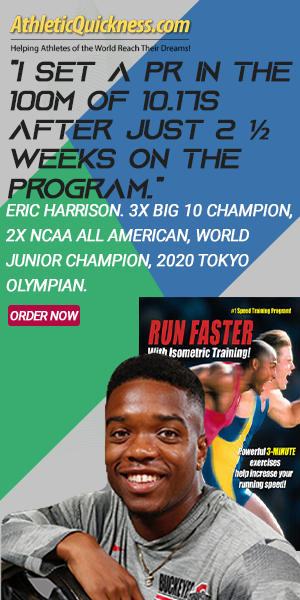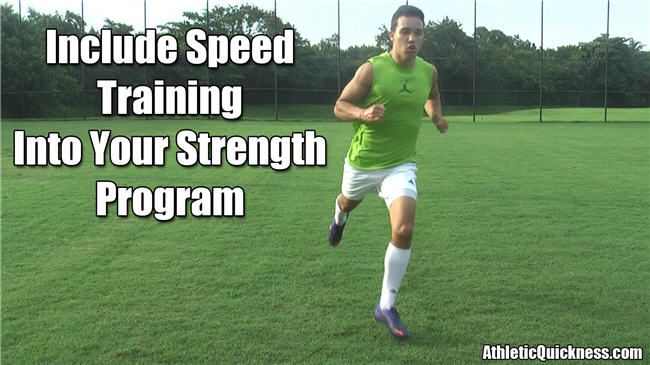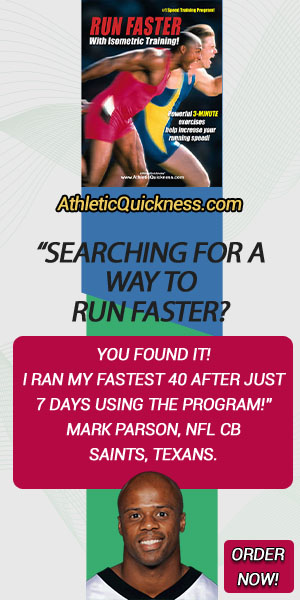“How do I include the AthleticQuickness.com Speed Training Program into my existing strength training routine?”
This is the question I hear more than any other. Because strength training can interfere with results of pure speed training, many athletes are asking how they should structure their workouts to take advantage of both strength training and speed training.
8 Tips for Including a Speed Training Program into Your Strength Training Routine
Remember, muscles have two distinct fiber types – fast twitch for muscle speed and slow twitch for muscle strength.
These different fiber types cannot be separated apart from each other and trained individually. Depending on your training methods, you either end up training the entire muscle for better strength or for better speed, but never for better strength and speed at the same time.
Therefore, in order to maximize your sports performance, beat out your competition, and advance your athletic career, you need at least two methods of training your muscles: One to train for speed and another for strength – using different techniques and different times. Here is how I recommend athletes schedule their workouts when they need to be both strong and fast – based on whether you are in mid-season or off-season.
Both in-season and off-season training:
Tip #1: Make sure you do our isometric speed training programs last and try to schedule your speed training session at least 6-8 hours after strength training. Doing our programs last will make good use of your muscles memory, allowing the entire muscle to remain in a quickened state for as long as possible. This is typically the rest of the evening and throughout the night. If you do our speed training program first, it is very likely that your strength training will wipe out the stored fast twitch response within your muscles leaving your muscles tired and heavy for extended periods of time.
Tip #2: Schedule the speed training exercises the same time each day. Your muscles will respond best if you choose the same time each day to train.
Tip #3: Try to coordinate the days that you strength train a muscle group (that is, with weights or plyometrics), so they do not overlap with identical muscles to be trained later that evening for speed training.
In other words, if you are going to weight train your hamstrings by doing leg curls on a Tuesday, for example, make sure that you are not also scheduled to speed train (isometric training with the resistance band) those same hamstrings later that evening.
Upper body weight training will not affect lower body speed training and vice versa. Feel free to do both on the same day without any negative effects.
Tip #4: After doing our speed training exercises for at least 4 to 6 weeks, you can begin to incorporate the four training modifications contained in our AfterBurner video.
[NOTE: The link to this video is emailed free to those who are already using an AthleticQuickness.com speed training program and will help you break through any plateaus or sticking points in your speed improvements and quickly give you additional speed and advantage in your sports performance.]
Off-season training only:
Tip #5: If you are several months away from the first game of the season, football for example, the best recommendation during this time period is to train each muscle group for speed with the resistance band three times a week. Continue on with all other strength training workouts as well. Don’t eliminate them. You need to be both strong and fast and the off-season is the best time to work on improving both.
Tip #6: At some point in during off-season training, you are probably going to want to measure your progress, usually in the 40 yard dash if training for running speed for example. When this time comes, you will need to eliminate all lower body strength training for at least 7 days and speed training for at least 3 days prior. Recovery time is just as important to a good training program as the actual programs themselves and this rest period will help insure that your muscles will be ready to perform when you want them to.
In-season training only:
Tip #7: Unlike off-season training, it is highly doubtful that time will permit you to speed train each muscle group three times a week. Therefore, the best way to speed train here is to do each muscle group two times a week – allowing at least 2 days of rest before a game.
Tip #8: It is very important not to over-train during the season. There simply is not enough time to recover from too hard of a workout (both strength and speed) and return to your peak performance in time for the game. Again, rest is just as important as the actual training sessions. If at all possible, allow at least 2 days of rest before any competition by just doing some light stretching/warm-ups the day before a game.
To maximize speed, try and get all of your heavy weight lifting workouts as far away from game time as possible. For example, if you have games on Friday nights and are required to lift weights throughout the week, try and convince your coaches to let you do your workouts on Sundays, Mondays and definitely no later than Tuesday. You can still do speed training isometrics with the resistance band up until Wednesday (2 days before the game) but absolutely no workouts of any kind on Thursdays (or the day before a game).
IMPORTANT REMINDER: Under ideal circumstances, all of the AthleticQuickness.com speed training programs recommend that you do not participate in any other types of training (weights, plyos, etc.) during the initial 14-day days of doing the speed training exercises. This is done to maximize your speed results quickly and will help eliminate any potential outside interference from strength training that could negatively affect your speed performance. It will also allow you to accurately assess the value of the speed training.
Many times however, this is simply not possible. If that is your situation, and you cannot put your strength training on hold for two weeks, then try to follow the program as outlined in the tips above as best as you can.
I hope you enjoy ongoing success with our speed training programs. If you have any questions or observations along the way, please contact us at: support@athleticquickness.com
Always glad to help,
Dr. Larry Van Such






